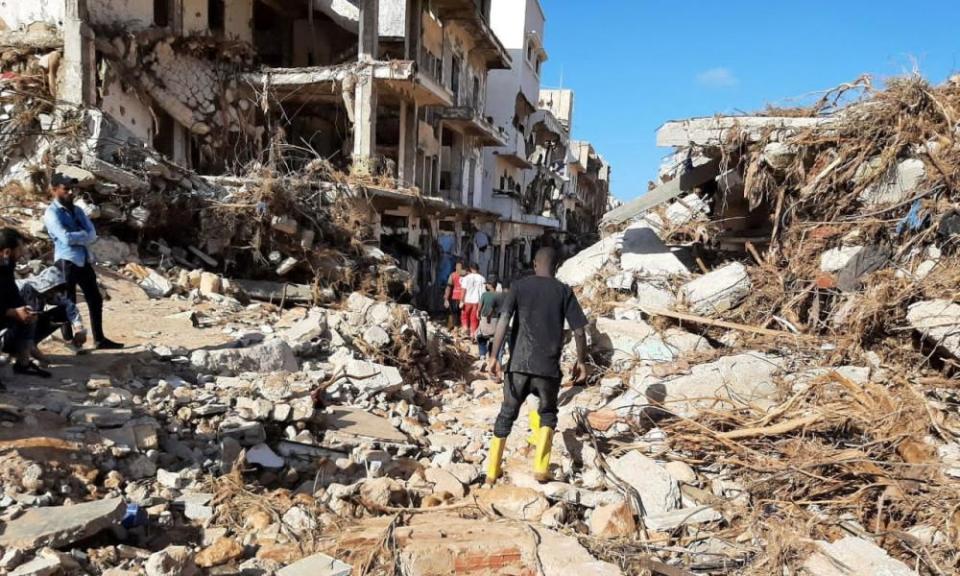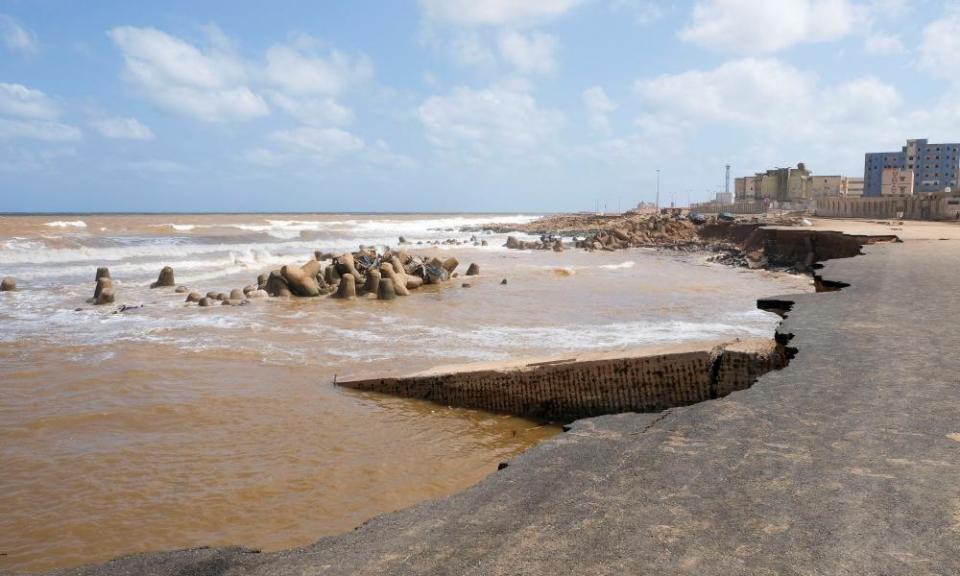‘Sea is constantly dumping bodies’: fears Libya flood death toll may hit 20,000
International aid is slowly starting to reach the devastated port city of Derna as questions are raised over how as many as 20,000 people may have died when Storm Daniel hit the northern coast of Libya on Saturday night.
Ten thousand people were declared missing by official aid agencies such as the Libyan Red Crescent, but the ominous higher estimate of 20,000 deaths came from the director of al-Bayda medical centre, Abdul Rahim Maziq.
Corpses still litter the street, and drinkable water is in short supply. The storm has killed whole families and, with the remoteness of some villages and the rudimentary nature of municipal government, it will take time for the death toll to be confirmed.
But the scale of devastation appeared even worse than officials had initially predicted. The “sea is constantly dumping dozens of bodies”, said Hichem Abu Chkiouat, the minister of civil aviation in the administration that runs eastern Libya, adding that reconstruction would cost billions of dollars.

The International Organization for Migration (IOM) in Libya said on Wednesday that at least 30,000 people had been displaced in Derna, the town most affected by Storm Daniel. IOM added that 6,085 were known to have been displaced in other storm-hit areas including Benghazi, with the number of deaths still unverified.
Such was the need to bury the bodies to avoid the spread of disease that hundreds were being buried collectively in one grave. Derna residents have been pleading for a new field hospital as the two existing hospitals in the town have become makeshift morgues.
Sea patrols were working along the coast trying to locate washed-up bodies, many of which were being taken to Tobruk for potential identification.
Related: Libya flooding: before and after satellite images reveal scale of disaster in Derna
There was a shortage of food and drinking water, and authorities were struggling to fully reinstate the internet. A technical committee for assessing the damage, formed by the roads and bridges authority, announced that the extent of the collapsed road network in Derna was estimated at 20 miles (30km). The area devastated by the floods covered 90 hectares (220 acres) and five bridges had been wiped out.
Aid agencies have been battling to reach the city of just more than 100,000 people, hampered by the destruction of roads. Helicopters were required, mainly provided by Egypt. The UK on Wednesday announced an initial aid package of up to £1m.
Mohamed Eljarh, a Libyan journalist travelling to Derna, said rescuers had yet to reach some parts of the city, especially in the east, as well as the nearby coastal town of Sousse and the municipality of al-Sahel. “Until late last night, there were pleas from some survivors under the rubble,” Eljarh told the Guardian, speaking from the nearby city of Tobruk.
He described the situation in Sousse and surrounding villages as a “new tragic episode”. “Hundreds of homes are buried under mud, debris and water. No help has arrived,” he said. “Other areas have been similarly affected. The death toll is going to be staggering.”
The bodies of some victims were being transferred to Tobruk, 100 miles east of Derna, in an attempt to speed up burials and to document the many dead.
The only functioning mountain road between Tobruk and Derna was clogged with traffic, made up of relief vehicles and desperate relatives who had gone in search of missing loved ones.
International aid is arriving from countries historically linked to Libya including Turkey, the United Arab Emirates and Egypt, where three days of mourning were declared. Help in the form of trucks and doctors is being sent from the west.
The country has been politically divided for years. But the impression remains that the international emergency aid operation has been slow to spring into action, with attention focused on the earthquake in Morocco, and experts taking time to realise the scale of the disaster.

France was sending a field hospital and about 50 military and civilian personnel able to treat about 500 people a day, Paris said on Tuesday.
As the tragedy unfolds, questions are being asked about how Derna was so exposed to the damage caused by Storm Daniel. Moin Kikhia, from the Libya Democratic Institute thinktank, said: “The environmental disruption of the storm was turned by endemic corruption and lack of governance into something of a biblical catastrophe. At times the water reached 20 metres high so people on the third floor were washed away to sea. Audit documents show these dams were not maintained for years.
“One can only hope that this leads to reflection in Libya and abroad about the need to elect a new single government.”
There is also concern that Derna and neighbouring Sousse, because of their proximity to Italy and Greece, were hubs for thousands of migrants trying to cross the Mediterranean, and many of them will have been in poor housing close to the port.
Rashad Hamed, a data specialist consultant at the UN children’s fund, Unicef, said: “The humanitarian catastrophe in Derna, Libya, is different from the humanitarian catastrophe in Marrakech, Morocco. The Moroccan earthquake could not have been avoided or mitigated, while the Derna disaster was caused by negligence and gross negligence, the price of which was paid by thousands of victims.”
He said the Wadi Derna dam “retained rainwater and the neglected spillway for the dam, which had not been cleaned for a long time, failed to drain the water. As a result the dam collapsed and the water swept the city and threw it into the sea.”
Political infighting in Libya has already started, with those in power seeking to avoid blame. Musa al-Koni, a member of the Libyan presidential council, said: “It had not been expected that this hurricane would be this strong and destructive to this extent, especially since the country had not witnessed such devastating storms before.”
Speaking on the Libya Al Ahrar channel, he said: “We dealt with the crisis without plans, and it is clear to the public what happened. We want everything to be done to the maximum and fastest, and now we do not have time to blame each other, and we must work as much as we can. None of us were exposed to what our people were exposed to in Derna, and it is natural for us to blame our institutions.”
Callout
Maj Gen Ahmed al-Mismari, a spokesperson for the Libyan National Army, which dominates in the east, said its units acted within the first hours of the storm’s arrival and carried out their duty to the fullest extent.
He said: “The Libyan people are patient and believe in fate and destiny, and what happened is God’s destiny, and we do not hold anyone responsible at all, and we console ourselves, the Libyans, and Muslims with this number, which is likely to increase in the coming days, but people must adhere to the instructions issued.”
Listing all the roads that had been closed, he added: “All the bridges in Derna had been vulnerable to these floods, and this created a challenge as all transportation routes were closed to us. We tried to find alternative routes, and every soldier must reach the citizen whatever the problem or dilemma was facing him.”
He said Libyans were welcoming displaced families, and hotels and schools had been opened to provide accommodation as development agencies provided cover, medicines and humanitarian services amid the continuing search and rescue mission.
He said support was arriving by air and sea but added that there were people south of the Green Mountain about which little had been heard.

 Yahoo News
Yahoo News 